If you are thinking juicing and a low-carb diet don’t work together, think again. Low-carb juice recipes do exist! Juicing is the perfect way to ensure you’re getting all the vitamins and minerals your body needs while limiting your carb intake.
Juicing combined with a low-carb lifestyle can work wonders for weight loss. If your body doesn’t have any carbohydrates to burn as energy, it’s going to burn that stubborn fat. And that’s what we are all after, aren’t we?
I’ll show you the best fruits and vegetables to juice on a low-carb diet and my favorite low-carb juice recipes. If you are on a ketogenic diet, hold on. I’ll have some keto juice recipes and useful tips for you, too.
Avoid Juicing Fruits When Trying to Lose Weight
 You don’t want to juice a lot of fruits when you are watching your carb intake and trying to lose weight. Fruits tend to be rich in simple sugars. They are still lower in carbs than pasta or bread, but much higher than most vegetables.
You don’t want to juice a lot of fruits when you are watching your carb intake and trying to lose weight. Fruits tend to be rich in simple sugars. They are still lower in carbs than pasta or bread, but much higher than most vegetables.
Fruit juices also deliver a high dose of calories relative to their volume. Juicing removes the fiber that is present in fruits. Without the fiber, the juices won’t satiate you like eating whole fruits does.
A better choice for your low-carb diet are juices made from vegetables. Most veggies tend to be low in calories, carbs, and sugar. They will provide your body with all the nutrients it needs while staying in your daily carb limit. To get the most juice out of your veggies, you’ll need a good juicer for leafy greens. Learn more: The Best Juicer for Leafy Greens.
Which Low-Carb Diet Are You Following?
It’s important to know that not all low-carb diets are the same. Low-carb diets vary widely in their restriction of carbs. A moderately low-carb diet might call for you to limit your carbs intake to 150 gram per day. In this case, you can add some more fruits to your juices without going over your limit.
A ketogenic diet requires you to restrict your carbs to below at least 50 grams per day. Some ketogenic diets want you to stay below 20 grams per day. A diet this extreme makes it impossible to juice any fruits whatsoever, and you will be limited to juice only low-carb vegetables.
No matter what kind of diet you are following, I’ll have some healthy low-carb juice recipes for you, that actually work. But let’s first have a look at the best juice ingredients, that won’t add much sugar to your juices:
The Best Low-Carb Fruits & Vegetables for Juicing
1. Celery
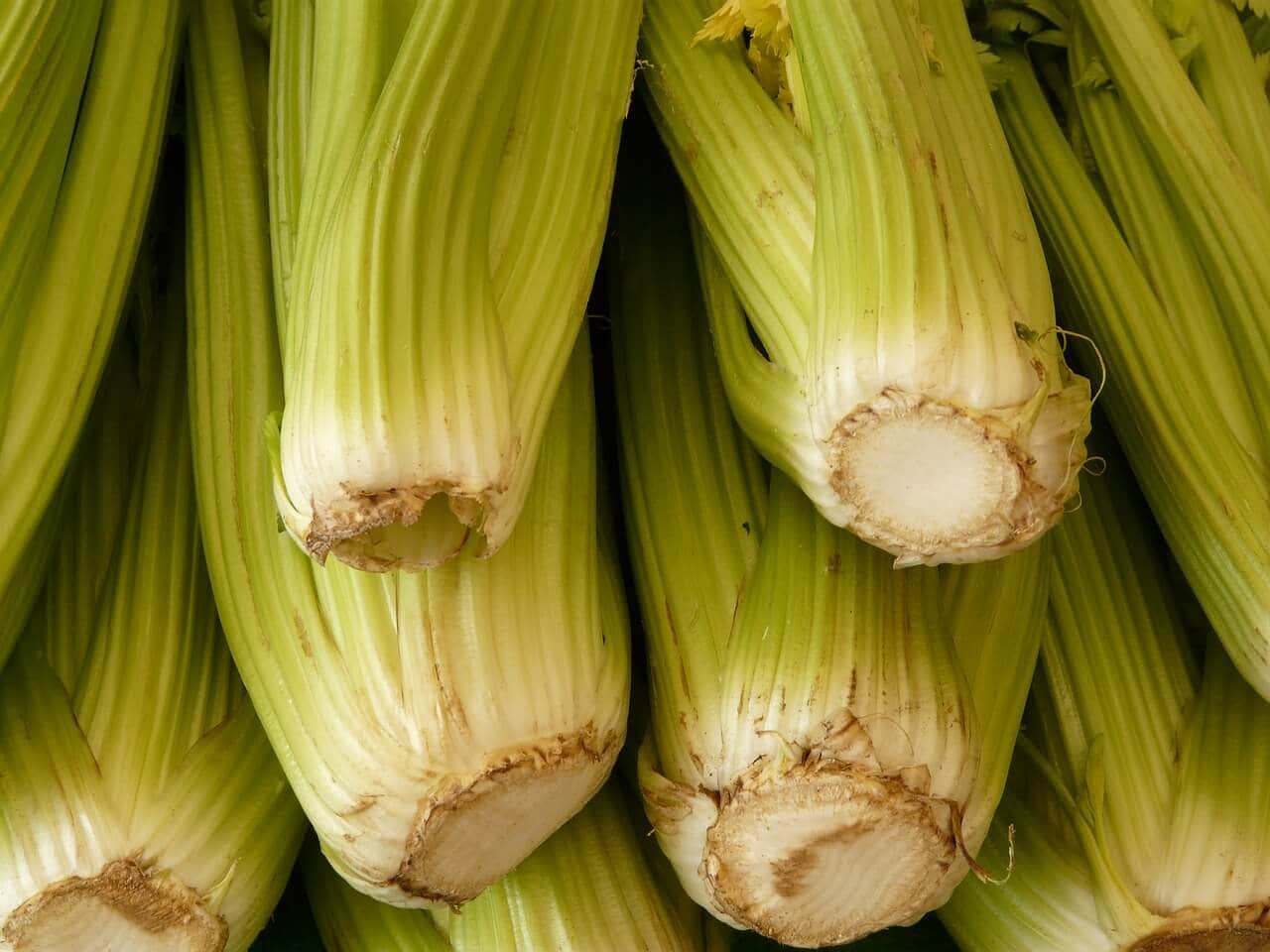 Celery clears up skin problems, aids in digestion and purifies your bloodstream. It’s also on the list of major alkalizing foods. I love to drink pure celery juice on an empty stomach in the morning. It has a great effect on my body and mind.
Celery clears up skin problems, aids in digestion and purifies your bloodstream. It’s also on the list of major alkalizing foods. I love to drink pure celery juice on an empty stomach in the morning. It has a great effect on my body and mind.
I know some people don’t like the taste of celery. If you haven’t juiced celery yet, try it anyway. The taste of celery juice is quite different from eating celery.
If you have tried it and can’t stand the taste of celery juice, you can substitute with zucchini, cucumber, cabbage or Romaine lettuce.
100g: Carbohydrate 3g; Sugar 1.3g
2. Zucchini
 Zucchinis contain B vitamins, which are great for boosting energy levels. Thanks to its vitamin C, it helps us protect against cold and flu. Zucchinis are also anti-inflammatory and may help prevent and reduce arthritis.
Zucchinis contain B vitamins, which are great for boosting energy levels. Thanks to its vitamin C, it helps us protect against cold and flu. Zucchinis are also anti-inflammatory and may help prevent and reduce arthritis.
Zucchinis can be used in any juice; their flavor is very mild – almost like cucumbers.
100g: Carbohydrate 3.1g; Sugar 2.5g
3. Romaine Lettuce
 Lettuce has a mild, pleasant taste and 96% water content. It contains many energizing B vitamins, which support our nervous system and help you maintain healthy skin. The vitamin A is excellent for vision health and protects our cells from free radical damage.
Lettuce has a mild, pleasant taste and 96% water content. It contains many energizing B vitamins, which support our nervous system and help you maintain healthy skin. The vitamin A is excellent for vision health and protects our cells from free radical damage.
The stems contain a milky latex, which has long been used for its sedative properties. You can add lettuce to your favorite juices; it won’t change the taste much and further boosts the nutritional value.
100g: Carbohydrate 3.3g; Sugar 1.2g
4. Radishes
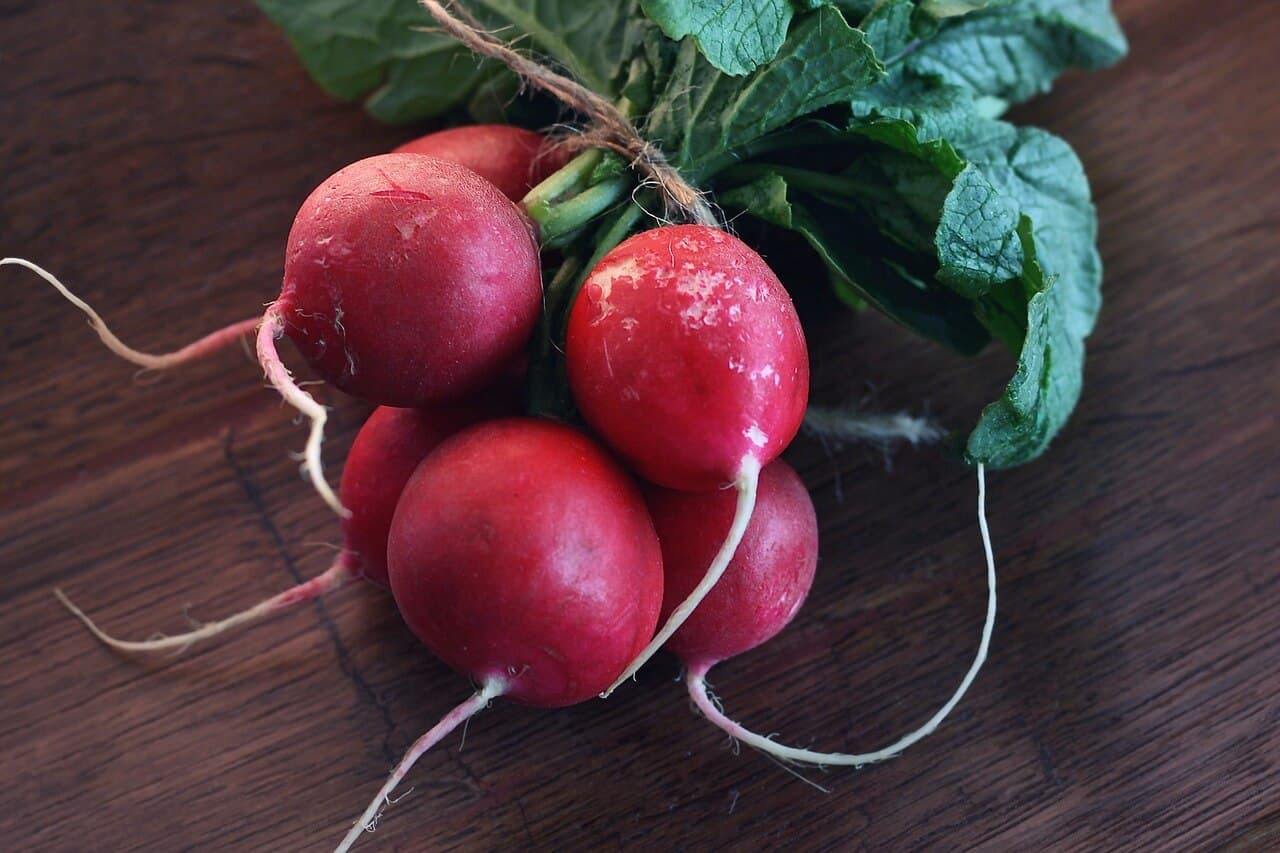 Radishes are used in Traditional Chinese Medicine (TCM) and Ayurveda to treat many conditions such as inflammation and kidney stones.
Radishes are used in Traditional Chinese Medicine (TCM) and Ayurveda to treat many conditions such as inflammation and kidney stones.
They support a healthy digestive system and are a good source of vitamin C. They contain isothiocyanates, which may help protect against certain types of cancer.
100g: Carbohydrate 3.4; Sugar 1.9g
5. Spinach
 When it comes to juicing spinach, you can call me Popeye. Spinach is the perfect low-carb juicing ingredient. 1 cup of raw spinach (30g) contains only 1 gram of carbs.
When it comes to juicing spinach, you can call me Popeye. Spinach is the perfect low-carb juicing ingredient. 1 cup of raw spinach (30g) contains only 1 gram of carbs.
It’s pretty much flavorless in your juices but is incredibly good for you. One ounce of spinach juice provides more than 100% of your daily intake of vitamin K. It’s essential for your bones and helps blood clot.
Spinach juice is also rich in minerals like potassium, iron, and magnesium. It’s full of skin-improving nutrients and antioxidants that help you achieve that all-natural glow.
100g: Carbohydrate 3.6g; Sugar 0.4g
6. Cucumber
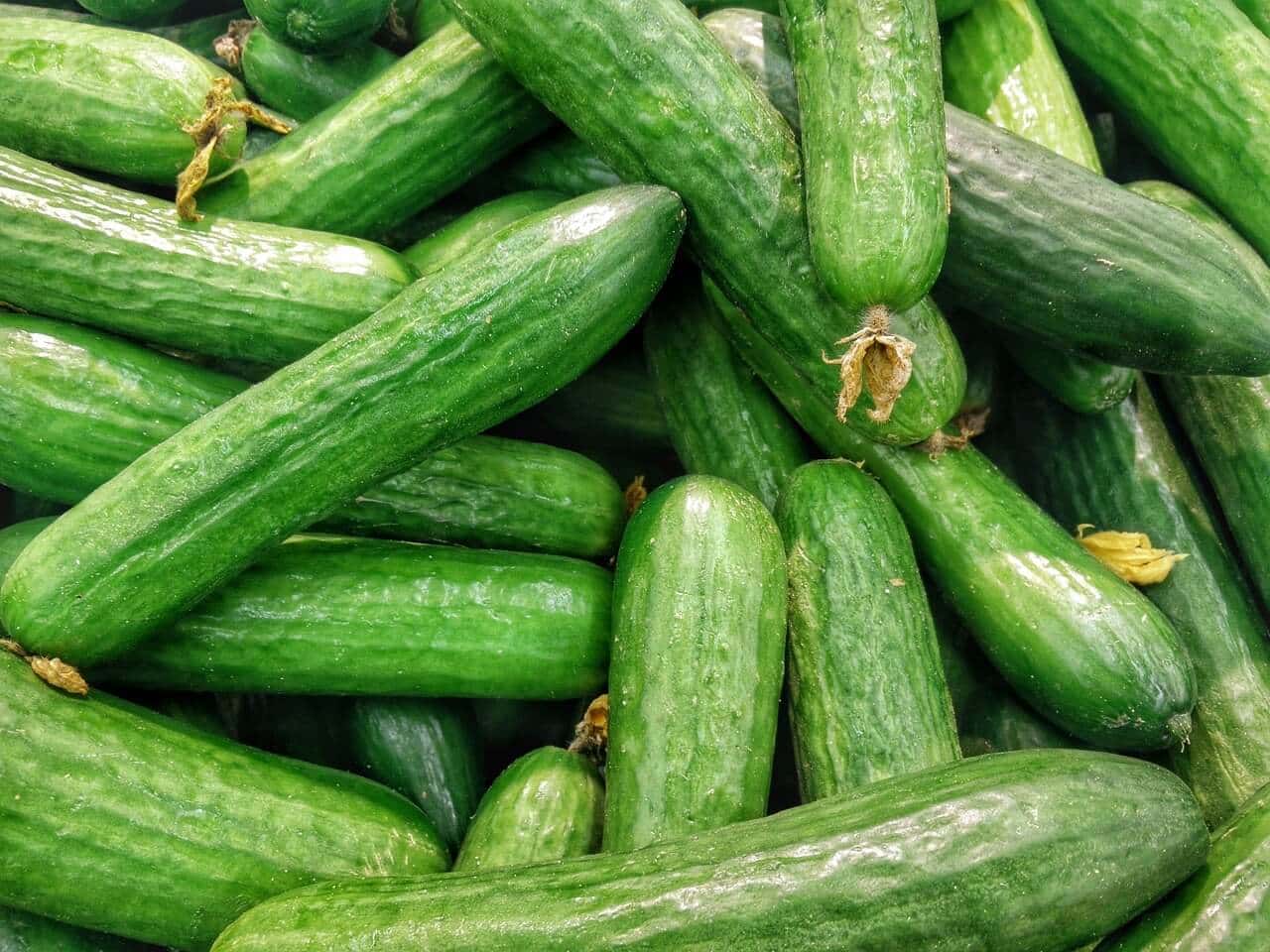 Cucumbers are my all time favorite for any juice. It’s what I call a base item. Base items are vegetables, that have high water content and a mild taste.
Cucumbers are my all time favorite for any juice. It’s what I call a base item. Base items are vegetables, that have high water content and a mild taste.
Cucumbers have some excellent health benefits, too. They boost your immune system, protect eyesight and promote digestion.
100g: Carbohydrate 3.6g; Sugar 1.7g
7. Swiss Chard
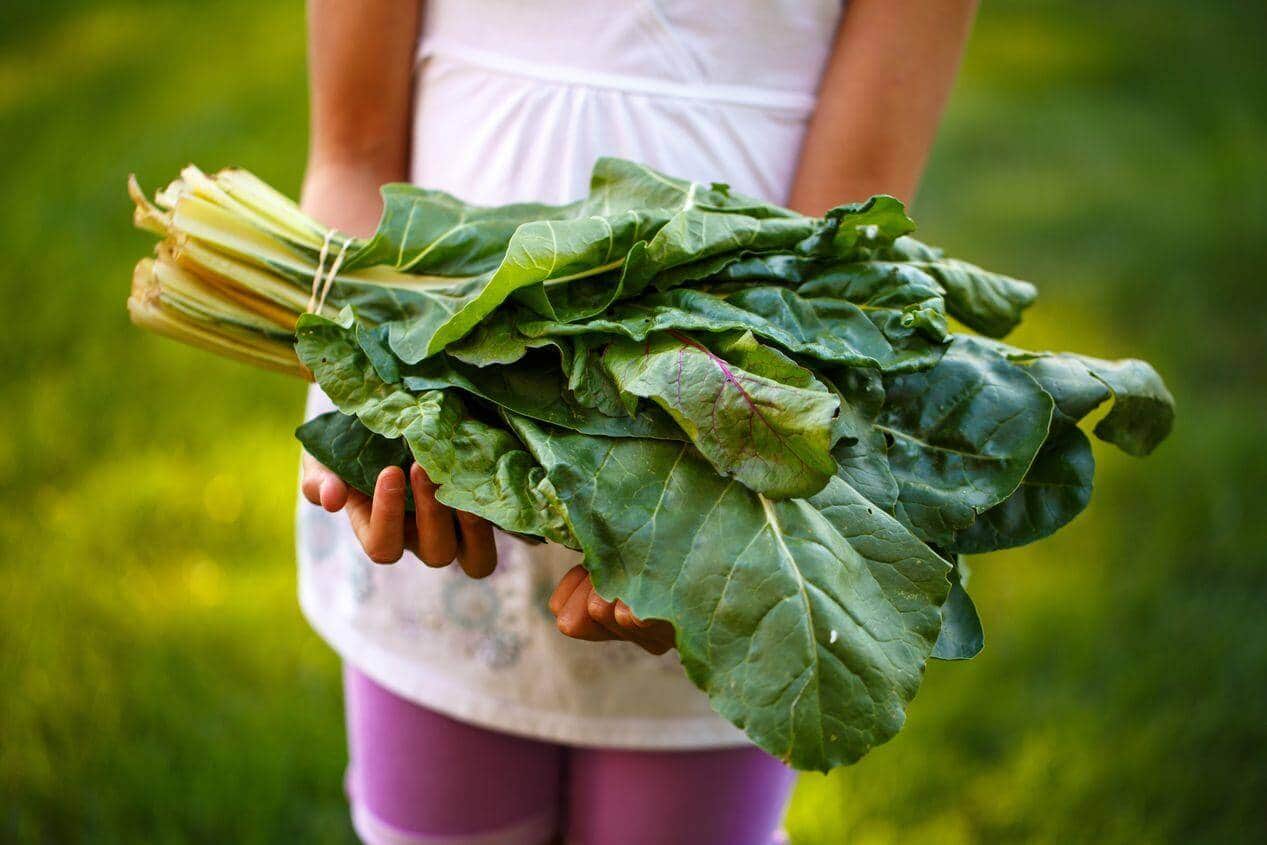 Swiss chard does not come from Switzerland like the name would imply. It’s actually a Mediterranean plant.
Swiss chard does not come from Switzerland like the name would imply. It’s actually a Mediterranean plant.
Like all leafy greens, Swiss chard is high in the blood clotting vitamin K. It’s also loaded with minerals like potassium, iron, and magnesium, as well as vitamin A and C.
Swiss Chard blends well with lemons, green apples, and ginger.
100g: Carbohydrate 3.7g; Sugar 1.1g
8. Tomatoes
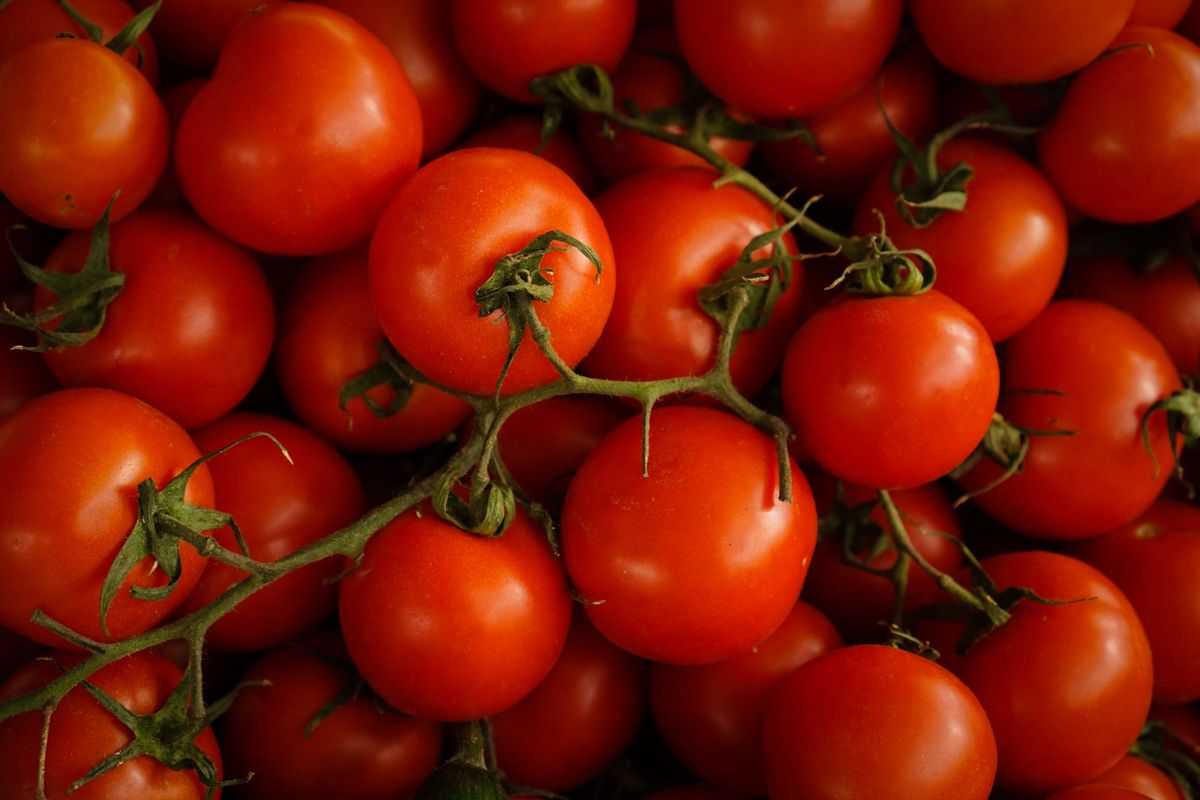 Although technically a fruit, tomatoes are often categorized as a vegetable. The bright red color comes from the antioxidant lycopene, which is one of the most potent antioxidants in the world. The darker the tomato, the more loaded it is.
Although technically a fruit, tomatoes are often categorized as a vegetable. The bright red color comes from the antioxidant lycopene, which is one of the most potent antioxidants in the world. The darker the tomato, the more loaded it is.
Lycopene has anti-aging properties and there is a good chance your cosmetics contain this powerful antioxidant. It has shown to reduce age spots and skin darkening. It promotes the production of collagen, which makes your skin firmer, it also makes your skin less sensitive to UV rays.
The benefits of lycopene are not limited to your skin. It keeps your eyes healthy, your bones strong, is good for your brain and lowers blood pressure. Some studies even show that lycopene may slow the growth of certain types of cancer.
100g: Carbohydrate 3.8; Sugar 2.6g
9. Asparagus
 Asparagus is rich in the amino acid asparagine, making it a natural diuretic. It helps flush excess fluid and salt from your body and can be beneficial to your urinary tract health.
Asparagus is rich in the amino acid asparagine, making it a natural diuretic. It helps flush excess fluid and salt from your body and can be beneficial to your urinary tract health.
It’s also loaded with the antioxidant called anthocyanin, which helps to fight the effects of aging. Anthocyanins have anti-inflammatory properties that may help protect against heart disease and cancer, as well as boost the immune system.
100g: Carbohydrate 3.9g; Sugar 1.9g
10. Radicchio
 Straight from Italy, this bright vegetable is a form of leaf chicory and has a somewhat bitter and spicy taste.
Straight from Italy, this bright vegetable is a form of leaf chicory and has a somewhat bitter and spicy taste.
Like lettuce, it has pain killing properties. Radicchio contains intybin, a mild sedative. It’s filled with potent anti-inflammatory and antioxidant properties, that boost your overall health.
It’s an excellent source of vitamin K, which is essential for healthy bones. Radicchio also contains inulin, a powerful compound with many health benefits. It may help you lose weight by controlling your blood sugar levels.
Radicchio is also rich in an entire spectrum of B vitamins that will make your skin, nails, and eyes shine.
100g: Carbohydrate 4.5g; Sugar 0.6g
11. Cauliflower
 The sulfur compound sulforaphane in cauliflower is used for the prevention of certain types of cancer. It has shown to improve kidney function and blood pressure.
The sulfur compound sulforaphane in cauliflower is used for the prevention of certain types of cancer. It has shown to improve kidney function and blood pressure.
Cauliflower is a good source of choline. It’s used to treat depression and dementia. It may boost cognitive function and improve memory and learning. Athletes also like to use choline as a supplement to enhance their performance.
100g: Carbohydrate 5g; Sugar 1.9g
12. Parsley
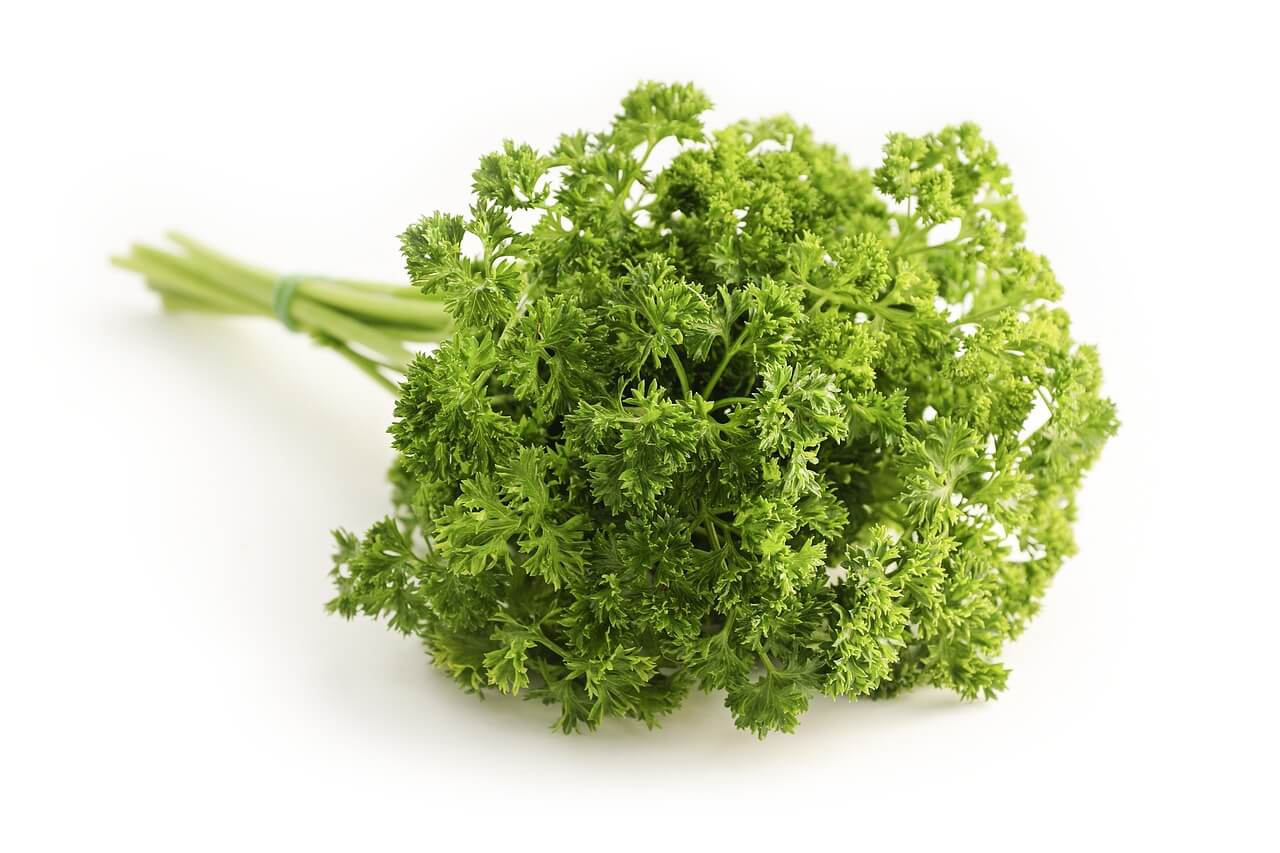 Parsley is the perfect ingredient for our low-carb juices. It’s rich in health-boosting chlorophyll, and the iron helps our bodies to build red blood cells, which provide us with the energy we need while maintaining a low-carb diet.
Parsley is the perfect ingredient for our low-carb juices. It’s rich in health-boosting chlorophyll, and the iron helps our bodies to build red blood cells, which provide us with the energy we need while maintaining a low-carb diet.
100g: Carbohydrate 6.3g; Sugar 0.9g
13. Red Bell Peppers
 If you are juicing bell peppers, choose red bell peppers.
If you are juicing bell peppers, choose red bell peppers.
Green Peppers are just unripe red peppers and only contain a fraction of the vitamins compared to their red siblings. Red peppers give your juices a good taste, as they tend to be sweeter than the green variety.
Red bell peppers are packed with vitamin B6 and folate, both of which can help prevent anemia.
Studies show that red peppers may even increase your metabolic rate and help you lose weight. When it comes to juicing bell peppers, seeing red is a good thing.
100g: Carbohydrate 6.7g; Sugar 4.4g
14. Fennel
 I love fennel’s licorice flavor; its juice combines very well with juices of other vegetables. The anethole, which gives fennel its exotic fragrance and subtle spice is known to reduce inflammation.
I love fennel’s licorice flavor; its juice combines very well with juices of other vegetables. The anethole, which gives fennel its exotic fragrance and subtle spice is known to reduce inflammation.
Fennel is rich in iron and histidine, which are helpful in the treatment of anemia. The high potassium content helps to keep your blood pressure in check. Fennel contains even slightly more potassium than bananas.
On top of that, fennel also possesses antibacterial and immune-boosting properties.
100g: Carbohydrate 7.3g; Sugar 3.9g
15. Kale
 Kale is relatively low in carbs and gives your body the nutrients it needs every day. It’s overflowing with vitamin K and iron. Per calorie, it has even more iron than beef!
Kale is relatively low in carbs and gives your body the nutrients it needs every day. It’s overflowing with vitamin K and iron. Per calorie, it has even more iron than beef!
It’s an excellent skin cleanser and detoxifies your skin from the inside. The high vitamin C content helps your skin produce collagen, which makes your skin firmer. The juice of just four kale leaves contains more than 100% of the recommended daily intake of vitamin C.
It’s also loaded with the carotenoids lutein and zeaxanthin; both are essential for good vision health. They protect our eyes from harmful UV rays and lower the risk for macular degeneration and cataracts.
The potassium, vitamin C and B6 support a healthy heart. They reduce the risk of high blood pressure, stroke and heart diseases.
Kale also contains the antioxidant alpha-lipoic acid (ALA). Research shows it may increase insulin sensitivity and help with type 2 diabetes.
Even if you don’t like the taste of this anti-inflammatory power food, I encourage you to get used to it. Start slow and work yourself up. It’s one of the healthiest vegetables you can put into your juicer. Learn more: How to Juice Kale: The Complete Guide
100g: Carbohydrate 8.8g; Sugar 2.3g
16. Lemons and Limes
 Lemons are low in sugar, but one of the most alkaline-forming foods out there. By juicing alkalizing foods, you are more likely to lose weight, and it can provide you with long-lasting mental clarity. Our bodies work at its best when in an alkaline state.
Lemons are low in sugar, but one of the most alkaline-forming foods out there. By juicing alkalizing foods, you are more likely to lose weight, and it can provide you with long-lasting mental clarity. Our bodies work at its best when in an alkaline state.
They are also a good source of vitamin C and powerful antioxidants that can help fight skin damage due to the sun or polluted air.
Lemons give an excellent flavor to almost every juice. If your low-carb juices don’t taste good, add half a lemon and see if you like it better. It’s my favorite way to fix a juice recipe.
100g: Carbohydrate: 9.3g; Sugar 2.5g
17. Beetroot
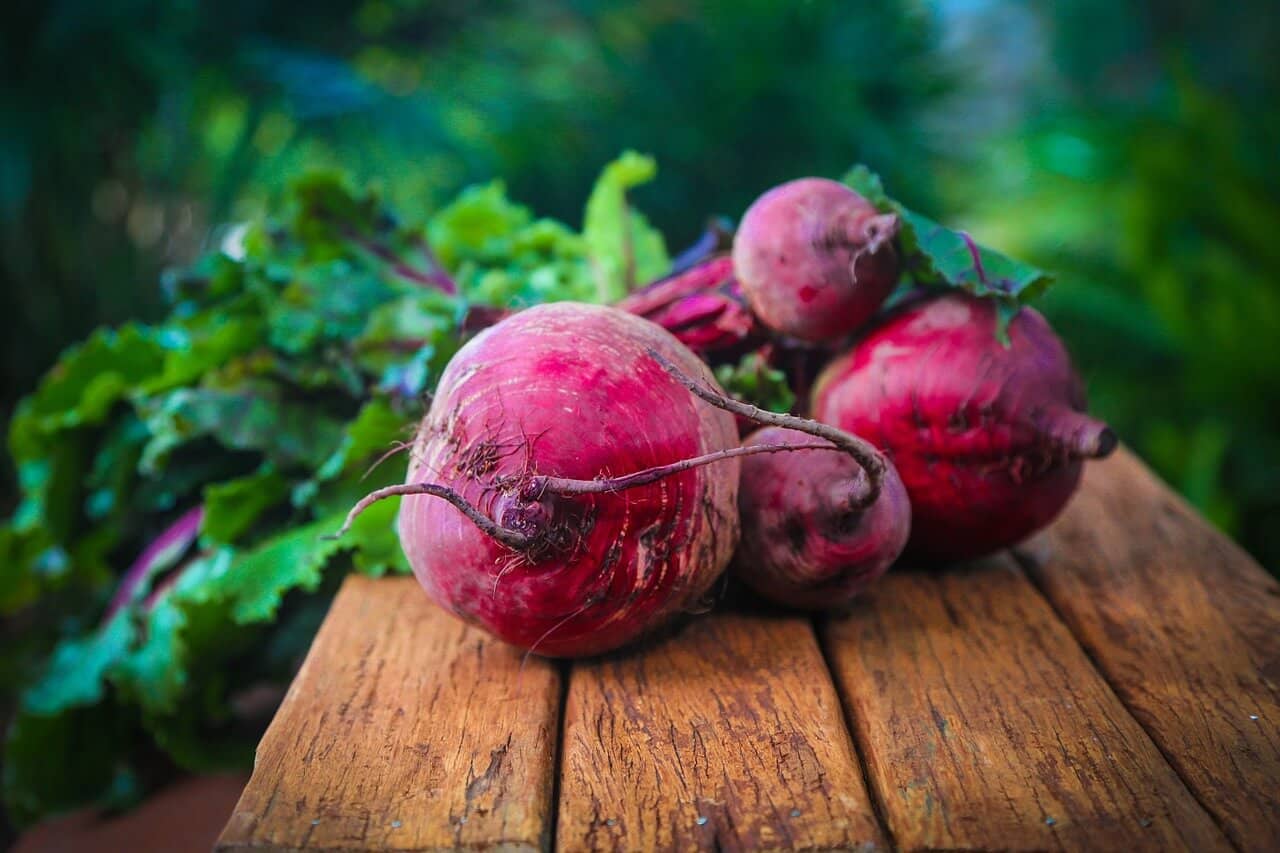 The nitrates in beet juice reduce blood pressure and can improve athletic performance. One study found that drinking beetroot juice before exercise could help you to endure up to 16% longer and make your workouts more intense.
The nitrates in beet juice reduce blood pressure and can improve athletic performance. One study found that drinking beetroot juice before exercise could help you to endure up to 16% longer and make your workouts more intense.
The betalains in beets are unique phytonutrients that have anti-inflammatory and detoxification benefits. It is these betalains that give the beet their beautiful red color.
You can also juice the beet greens, the greens are even higher in nutrients than the actual beets.
100g: Carbohydrate: 9.6g; Sugar 6.8g
18. Berries
 Berries are loaded with antioxidants, which fight free radicals.
Berries are loaded with antioxidants, which fight free radicals.
Whether or not we like it, we are all exposed to free radicals. They are molecules that are produced by environmental exposure like polluted urban air, pesticides and hundreds of other synthetic products in every aspect of our environment.
Free radicals cause many of the physical signs of aging, such as age spots, wrinkles, and dry skin. When antioxidants levels in our body are lower than those of free radicals, we age more rapidly.
Free radicals are not only associated with faster aging but can also cause many diseases, including cancer.
Let’s fight back with berries. The high antioxidant levels in berries neutralize harmful free radicals and protect our cellular structures in our bodies from their damaging effects.
Compared to other fruits, berries are low in carbs.
100g: Carbohydrate 12g; Sugar 5g
19. Green Apples
![]() Green apples tend to have slightly fewer carbs and sugar than red apples. They also contain fewer carbs than other fruits. That’s why I prefer them in my low-carb juice recipes.
Green apples tend to have slightly fewer carbs and sugar than red apples. They also contain fewer carbs than other fruits. That’s why I prefer them in my low-carb juice recipes.
Green apples give our juices a great flavor. However, we still have to use them sparingly, as they are still a lot higher in carbs than the other ingredients we use.
100g: Carbohydrate 14g; Sugar 9.6g
Low-Carb Juice Recipes
 You can further limit your carb intake by reducing the serving size. To get the highest juice yield and the best juice quality possible, you’ll need a masticating juicer. Masticating juicers became less and less expensive during the last few years, you can get a decent one for $100. Here’s a complete guide: Best Juicer for Greens.
You can further limit your carb intake by reducing the serving size. To get the highest juice yield and the best juice quality possible, you’ll need a masticating juicer. Masticating juicers became less and less expensive during the last few years, you can get a decent one for $100. Here’s a complete guide: Best Juicer for Greens.
Low-Carb Juice #1
Ingredients
- 3 stalks Celery
- 2 leaves Kale
- ½ inch Ginger Root
- 1 Lime
- 1 handful Spinach
Instructions
-
Peel the Ginger. Peel lime, if it's not organic. Enjoy!
Recipe Notes
- Total Juice Yield: 4 oz (3.05g carbs/1 oz)
- Total Carbohydrates: 12.22g
- Sugars: 2.77g
- Fat: 0.74g
- Protein: 3.35g
Low-Carb Juice #2
Ingredients
- 2 stalks Celery
- 1 handful Parsley
- 1 Lime
- 3 leaves Swiss Chard
- ½ inch Turmeric
Instructions
-
Peel the lime, if it's not organic. Enjoy!
Recipe Notes
- Total Juice Yield: 4 oz (2.95g carbs/1 oz)
- Total Carbohydrates: 11.81g
- Sugars: 2.5g
- Fat: 0.63g
- Protein: 3.17g
- Calories: 35
Low-Carb Juice #3
Ingredients
- 3 stalks Celery
- 1 Cucumber
- 2 handful Spinach
- ½ Apple green
- ½ Lemon
Instructions
-
Peel cucumber & lemon, if they're not organic. Core the apple. Enjoy!
Recipe Notes
- Total Juice Yield: 10 oz (2.26g carbs/1 oz)
- Total Carbohydrates: 22.62g
- Sugars 11.97g
- Fat: 0.7g
- Protein 3.39g
Low-Carb Juice #4
Ingredients
- 1 Bell Pepper red
- ¼ head Romaine Lettuce
- 1 Cucumber
- 1 handful Parsley
Instructions
-
Peel cucumber, if it's not organic. Enjoy!
Recipe Notes
- Total Juice Yield: 8 oz (2.22g carbs/1 oz)
- Total Carbohydrates: 17.79g
- Sugars: 8.44g
- Fat: 1.02g
- Protein: 4.31g
Low-Carb Juice #5
Ingredients
- 4 stalks Celery
- ½ Beet
- ½ Lemon
Instructions
-
Peel lemon, if it's not organic. Peel the beetroot. Enjoy!
Recipe Notes
- Total Juice Yield: 4 oz (2.17g/1 oz)
- Total Carbohydrates: 8.68g
- Sugars: 4.12g
- Fat: 0.32g
- Protein: 1.54g
Low-Carb Juice #6
Ingredients
- 3 leaves Swiss Chard
- ½ Cucumber
- ½ inch Ginger
- ½ Lemon
Instructions
-
Peel the ginger. Peel lemon & cucumber, if they're not organic. Enjoy!
Recipe Notes
- Total Juice Yield: 4 oz (2.14g carbs / 1 oz)
- Total Carbohydrates: 8.57g
- Sugars: 2.97g
- Fat: 0.36g
- Protein: 2.97g
Low-Carb Juice #7
Ingredients
- 3 leaves Kale
- 4 stalks Celery
- 1 Cucumber
- 3 handful Spinach
Instructions
-
Peel cucumber, if it's not organic. Enjoy!
Recipe Notes
- Total Juice Yield: 9 oz (2.02g carbs/1 oz)
- Total Carbohydrates: 18.22g
- Sugars: 6.43g
- Fat: 1.24g
- Protein: 6.5g
Low-Carb Juice #8
Ingredients
- 4 stalks Celery
- ½ Cucumber
- 1 handful Parsley
- 1 handful Mint
- ½ Lemon
Instructions
-
Peel lemon & cucumber if they're not organic. Enjoy!
Recipe Notes
- Total Juice Yield: 6 oz (2.02g carbs/1 oz)
- Total Carbohydrates: 12.15g
- Sugars: 4.17g
- Fat: 0.65g
- Protein: 2.74g
Keto Juice Recipes
 If you are on the ketogenic diet, I would suggest you limit your daily serving size to 4 ounces. This way your juice should contain less than 8g carbs per serving.
If you are on the ketogenic diet, I would suggest you limit your daily serving size to 4 ounces. This way your juice should contain less than 8g carbs per serving.
Keto Juice #1
Ingredients
- 3 stalks Celery
- ½ Cucumber
- ½ Fennel
- 3 leaves Swiss Chard
- 1 handful Spinach
- ½ Lemon
Instructions
-
Peel lemon & cucumber if they're not organic. Enjoy!
Recipe Notes
- Total Juice Yield: 9 oz (1.97g carbs/1 oz)
- Total Carbohydrates: 17.75g
- Sugars: 7.27g
- Fat: 0.69g
- Protein: 4.52g
Keto Juice Recipe #2
Ingredients
- 3 Tomatoes
- 3 stalks Celery
Instructions
-
Wash tomatoes & celery. Enjoy!
Recipe Notes
- Total Juice Yield: 10 oz (1.24g carbs/1oz)
- Total Carbohydrates: 12.36g
- Sugars: 7.81g
- Fat: 0.65g
- Protein: 2.81g
Vegetable Juicing and Ketogenic Diet
The keto diet sends your body into a state of ketosis. Ketosis is a metabolic process your body goes into when it doesn’t have enough carbs from food to burn for energy. Instead of carbs, it burns fat, and as a part of this process, it makes ketones.
The ketogenic diet is a very low-carb, high fat diet. It contains a lot of meat, fish, eggs, nuts, cheese and natural fats. Keto diets limit the carb intake to 50 grams per day, ideally below 20 grams.
I know from personal experience that a keto diet is very effective. I followed an extreme keto diet many years ago, limiting my carbs below 20g, many days even below 10g. I could literally see my fat melting away before my eyes, without ever feeling hungry.
But reflecting now, I realize I wasn’t healthy back then. The only thing I cared about was my looks. I would do anything to look better, without listening to my body and give it what it needed. The diet I followed back then consisted of meat, oil, diet soda, eggs and nothing else.
Keto diets are effective, but should only be used under clinical supervision and for short periods. Don’t make the same mistakes I did back then and incorporate some healthy greens in your keto diet. You will feel and look better.
I might have looked lean, but I felt miserable at that time. I could have had the same weight loss effects, but feeling great and being more healthy, if I just would have known about juicing back then.
It’s possible to juice low-carb vegetables that won’t send you out of ketosis. Don’t expect keto juices to taste like a dessert, as they are mostly green vegetable juices, but they are totally worth it. They will give your body all the vitamins, minerals and phytonutrients it needs.
You can sweeten your keto juices with monk fruit. It’s a 1:1 sugar replacement that has been used for hundreds of years as a natural sweetener. Monk fruit has no calories, no net carbs and no effect on your blood sugar. It’s 300-400 times sweeter than sugar and has potent antioxidant properties.
For me the taste is much more like sugar, I really don’t like the aftertaste of other sweeteners like stevia. You can use monk fruit to sweeten almost anything; it’s not limited to your healthy green juices.
Find this post helpful? Don’t forget to share on Pinterest!
Is Juicing Safe for People With Diabetes?
Many people who have diabetes fear that juice is “too high in sugar” or “too high in carbs” and avoid it altogether. Making your own juice is different than buying juice from the grocery store. You can control precisely what’s going in there and how much sugar is added.
As a diabetic, it’s best to avoid pure fruit juices. They contain large amounts of sugar which send your blood sugar soaring. It’s healthier for you to eat whole fruits than drinking juices made from fruits.
People with diabetes should focus on vegetables and diabetes-friendly fruits. I would recommend you consider consuming your fresh juices with a meal and follow the 80/20 rule.
The 80/20 guideline is simple. Drink juices that are made of at least 80% vegetables and only 20% fruits. One piece of fruit for every cup of chopped vegetables.
Please remember that vegetables can be sweet too. Limit the number of root vegetables and starchy vegetables you put into your juices, as these tend to contain higher levels of sugar.
As a diabetic, I would suggest you add spices and herbs to your juices that offer additional blood sugar benefits.
Herbs & Spices to Lower Blood Sugar
Cinnamon
Cinnamon doesn’t contain a lot of vitamins or minerals, but it’s a potent antioxidant. It may help lower blood sugar by increasing insulin sensitivity. Your body then requires less insulin to lower your blood sugar levels.
Advice: Please don’t overdo cinnamon. It would be wise not to exceed 1 gram per day, as large amounts can potentially cause liver damage.
Ginger
Ginger is a herb that has been used for thousands of years to treat digestive and inflammatory issues. More recent research suggests it helps with diabetes as well. Juicing up to 4 grams a day may help regulate insulin production and lower your blood sugar levels.
Turmeric
Turmeric is used in Asian cuisine and is the main ingredient of curry. It has long been used in Eastern medicine for diabetes. Turmeric has antioxidant and anti-inflammatory properties that can help you maintain stable blood sugar levels. Tumeric’s active component, curcumin, also may decrease the level of glucose in the blood.
If you are trying to limit your carb intake, stick mostly with lower-carb veggies. 100% pure fruit juices are not a good choice if you’re looking for a juice that is low in sugar. Limit the serving size of your low-carb juices to 4 ounces, if you are following a ketogenic diet. Even 4 ounces will provide you with enough of the nutritional benefits of real vegetable juices.



I used to be among those that that think low carb and juicing can’t work together not until I read this post. This article is really informative and educative. So juicing and low carb can work together for weight loss, I gotta get a juicer and finally start implement this into my life.
Sure, low carb and juicing does work, however don’t expect these juices to taste like a dessert, as they’re mostly vegetable juices.
Ketogenic diet is a beautiful way to loose weight and stay fit! I didn’t know you can juice most of these vegetables. It seems I need to start taking some those vegetables juices that be a good change of life style instead of always taking fruits as only source of juice. Love your website, I already learned a lot.
You can juice almost anything 🙂
Leafy greens are some of the most nutrient-dense foods on the planet, it’s always good to incorporate them into your diet and juicing greens is the easiest way to do it.
I must thank you for sharing such nice recipes for a healthy life. I need to lose some pounds and I think that this can help me in achieving my goals. I always prefer nature and I hate when people run for some type of supplements or chemicals. Great topic, I will start making these juices.
Sounds good! These juice recipes definitely can help you lose some pounds if you incorporate them into a healthy, balanced diet.
Hello and thanks for another awesome article! Thanks also for providing so many recipes to try. I appreciate that because I have read about the health benefits of juicing in many places, but never knew where to start as far as ratios and what kinds of vegetables to combine. One question I do have is you mentioned that juicing strips away the fiber from fruits, but can’t it also do the same for vegetables? Can you get the same health benefits plus the fiber if you did more smoothies or do a lot of vegetable make-ups not really lend themselves to that type of preparation?
When it comes to juicing versus blending there are many different opinions. I can only tell you about my experience, I do make both smoothies and fresh juices almost daily for years now. If I had to choose one, I’d go for juicing, it just gives me this nice feel good energy. You won’t believe it until you experienced it yourself.
Just try it for a few days. I’d recommend to juice mostly fresh, organic leafy greens with very little fruits added. Juicing strips away the fiber from both fruits and vegetables, and your body can absorb all the nutrients from it much quicker. It goes directly into your bloodstream and hits you in almost an instant.
We are right into our Keto mission at the moment and loving it! So much more energy and vitality compared with other diets. And talk about shredded.
We feel like we are 19 again, our bodies are trim and I can keep up with kids, well the kids have to keep up with me!
These juice recipes look really amazing, we are going to give them a go, they should compliment our new way of life perfectly. We have begun using Pruvit products, which really get you into ketosis quickly and keeps you there all day.
Wow, I can’t believe you can put these vegetables into a shake! I would be keen to see what it tastes like, I bet it is so healthy.
Which recipe is your favourite? I think mine would be number 8, I love the flavour of mint!
Thankyou for opening my eyes to new things.
I think we’re in the same boat, I love mint, too. So, if I had to choose one I’d go for number 8. These low carb juice recipes are generally low in fruits (as fruits contain a lot of carbs), so they might not be the most delicious juice recipes out there, but they’re worth it. Ketogenic and low carb diets in general do work wonders, if they’re done the right way.
It is interesting to know that fibers are actually good for our health when trying to lose weight. The emphasis on many health books is to limit intake of refined sugar. I am actually learning that fruits also contain a high percentage of simple sugars. For me, cucumber would be a good substitute for celery due to cucumber’s almost neutral taste. For its amazing water content and immune system boosting property, I should pay closer attention to this simple and yet powerful fruit. I have book marked your page. I’ll be back for more. Thanks for sharing this.
Thank you very much. It’s always good to educate yourself about healthy nutrition.
I really love vegetable and fruit smoothies, unfortunately I own just a standard blender which I know is inadequate. I can do some fruits, but not vegetables, unless I want chunky smoothies. I love that there’s such a large variety of masticating juicers to choose from and prices to fit my budget. I can purchase a quality machine without breaking the bank. Veggie juices here I come, no more excuses. Thank for sharing!
Virginia
Hi Virginia, you’re right. These recipes won’t work with a blender, you’ll need a juicer. 🙂
Thanks a lot for all these recipes and different vegetables I can use for juices in the future. I recently bought a nutribullet, and while it’s not really juicing, I can use them same ingredients to make some good smoothies.
Out of all these recipes you provided, which ones do you find the tastiest?
Also are anyone of these good for people looking to lift weights and gain muscle?
Hi Michael, I wouldn’t use a nutribullet to make these juices, I think you’ll need a juicer. If you want delicious recipes for your nutribullet, check out our smoothie recipes:
Smoothie Recipes
I like the recipes with lemon and apple the best, I also love a minty flavor. So, for me, it’s #3, #8. You can always add more fruits, if you’re on a moderate low carb diet.
Wow, you can juice out of a cauliflower? I never knew that. I’ve always find it challenging to juice vegetable because of the bland and non-sweaty taste. The most I would get is from celery juices, but the rest are so unexciting for the taste buds. But that doesn’t mean I wouldn’t want to try.
So thanks for sharing those recipes with us. I see you have some with Tumeric too so it would be interesting to see how that would turn out. Love your site by the way – it’s so refreshing.
Thanks, Cathy. You can juice almost anything 🙂
You might want check out: How To Make Green Juice Taste Better
I couldn’t have read this post at a better time. I’m a bit worried because I’ve gained excessive weight over the Christmas holiday. I’ve been looking for ways to cut down the fat without dropping my productivity level at work. I would like to try one of your keto juice recipes. My only worry is having enough energy to carry out my daily routine
Don’t worry, your energy levels will be fine as long as you incorporate enough greens and healthy fats into your diet.
Low carb juice recipes? Didn’t even know they existed.
I’ll have to try out one of these recipes.
My Hurom juicer will be finally back in action!
Low carb Juice 3 is almost perfect..cucumber, spinach, apple, and lemon sound good to me.
Thank you for great ideas for juice.
Have a nice day,
Leo
Hi Leo, sounds good. Would love to hear back from you how you’ve liked it.
HI!!! I have recently tried to cut out a bunch of carbs. It’s amazing how many thing have so much sugar in them! As I am also trying to lower down my blood sugar, as I am pre-diabetic. It’s good thing that I’m still able to enjoy these refreshing juices!! 🙂
Hi Josefine,
I’m sure these juices can help you control your blood sugar. As a pre-diabetic you can still add some fruits to your juices, I would stick to 80/20, 80% veggies and 20% fruit. Wish you all the best!
Hi. I’m very familiar with juicing but I’m trying to understand your carb count. When you say
Total Carbohydrates: 12.36g
Sugars: 7.81g
Is my net carb count 7.81?
Thank you so much for the great recipes so I can still juice while staying in my carb range.
Hi Danelle,
Thanks for stopping by!
To be honest with you, I always found the term “net carbs” confusing and hard to count. If you’re following a ketogenic diet, I would count total carbohydrates as net carbs, just to be on the safe side.
Hi can u freeze the juices or smoothies if I did meal prep on the weekends for work the following week? If yes how long wil they be still good or fresh if frozen?
Hi Trina, thanks for reaching out. You can freeze fresh juice or smoothies and extend their shelf life this way by several months. Frozen juices and smoothies should be good for up to 3 months. I covered freezing fresh smoothies in this article, please feel free to check it out: https://vibranthappyhealthy.com/how-long-do-smoothies-last
What do you do when you are allergic to both cucumber and celery?
Hi Jen, are you allergic to zucchini as well? You can substitute cucumbers with zucchinis, they have a similar mild flavor. You can also substitute celery with fennel or bok choy, both quite low in carbs.
Red Bell Peppers are high in fructose, avoid if you are following a keto diet
Hi Jordan, thanks for your input. Red bell peppers shouldn’t contain more than 7g carbs per 100g.
Very useful. However when you talked about kale “per calorie it’s got more iron than beef!” Uhhhh how much volume of kale do you have to consume in order to reach the calories of beef Lmao. Not really comparing apples to apples there I must say
Hi Paloma,
haha, yes you’re absolutely right. Thanks for stopping by!